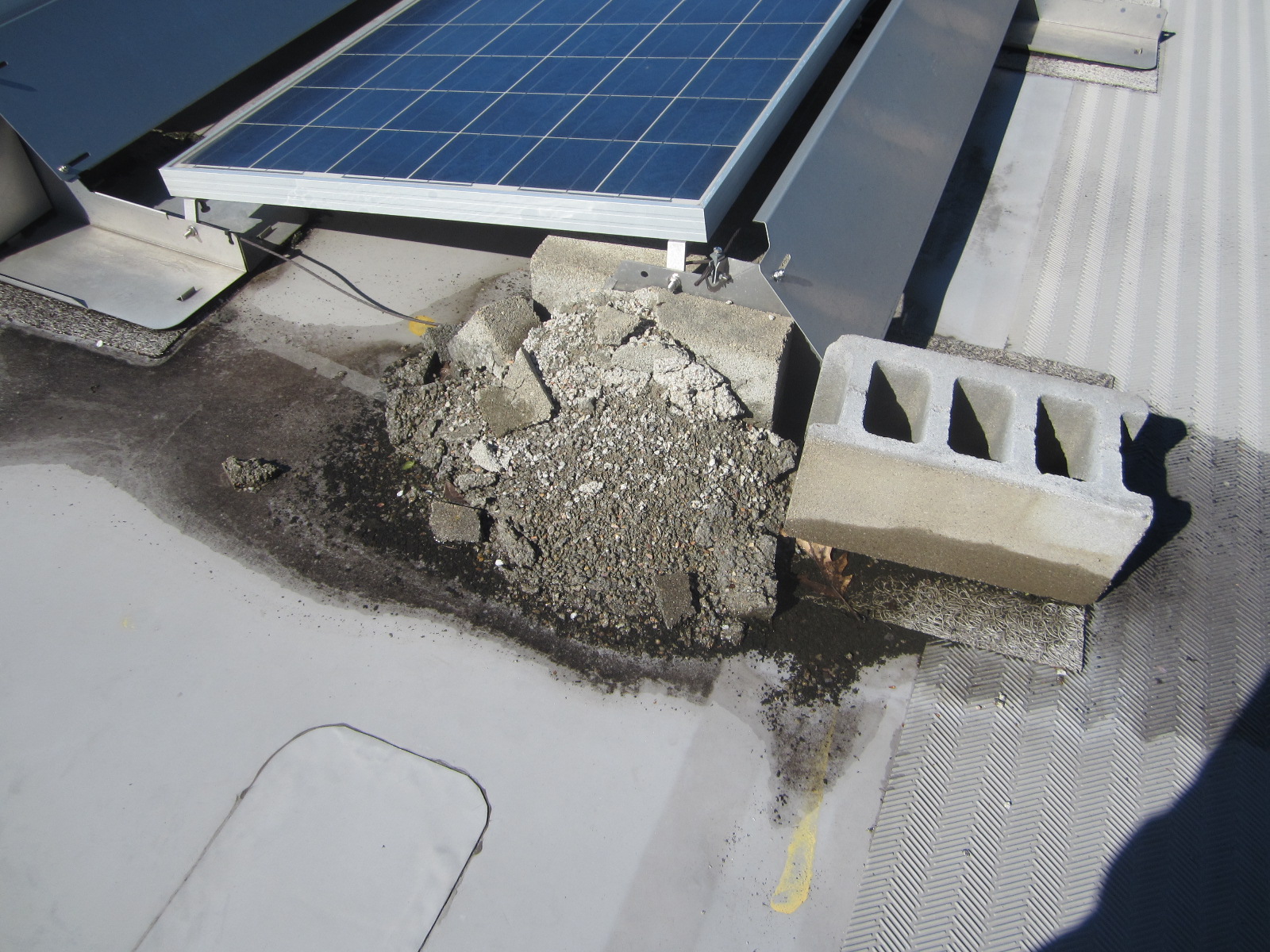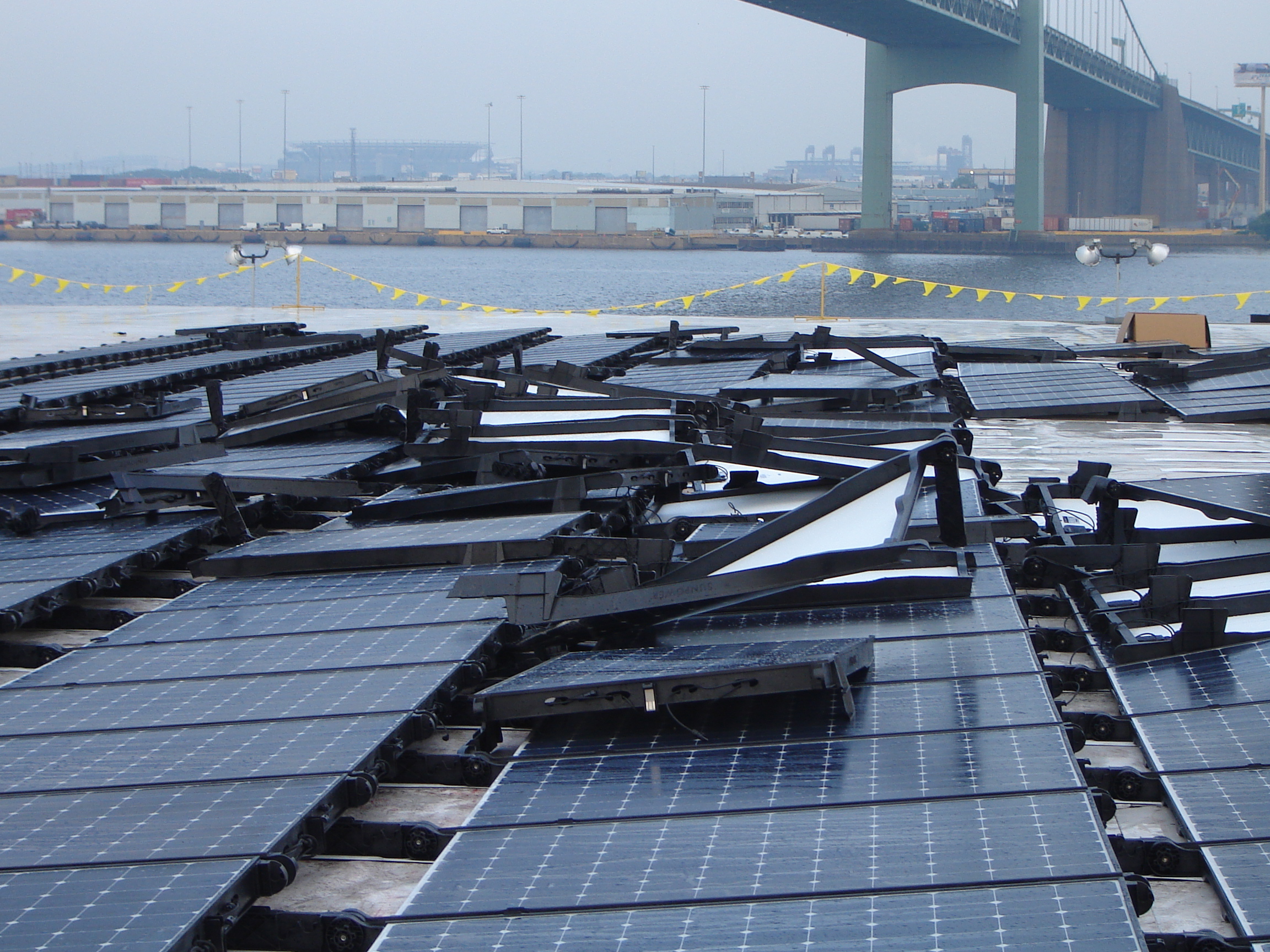Up On The Roof: Is ballasting really safer than anchoring?
When rooftop solar became more commercially widespread in the early 2000's, Building Codes around the world simply did not have any instructions on how to calculate wind effects on tilted panels on a flat roof. As time passed, and PV racking manufacturers started testing their products in wind tunnels, the industry started to define several unknowns, some of which are still in discussion today. What portion of the structure acts like a single structural element (called "tributary area" by specialists)? What is the effect of a wind deflector?

Almost two decades later, and after installing collectively gigawatts of flat commercial rooftop solar, our industry now has a more thorough understanding of how wind affects a solar system. But ballasted systems still move, and sometimes (albeit rarely) fly off the roof and cause considerable equipment damages.
While any other industry attaches their equipment's to a building's structure with bolts and screws, our industry still loads our high tech, space-age solar cells panels with... rocks to hold them in place!
It is generally assumed by PV project developers that roof penetration carries a risk of leaking. As technology and knowledge about wind physics evolve, however, experts are starting to consider direct attachment much more seriously.
According to experts, ballasted systems with wind deflectors require very thorough analysis of the racking structure and its location and shape on a given roof, and some risks are too easily overlooked. For instance, wind deflectors that can bend under wind pressure may not be as efficient to limit uplifts as theoretically thought. Also, as PV racking manufacturers had their system wind tunnel tested, they found out that their results did not always scale well on large or tall buildings of different shapes. It became clear that PV system's wind engineering had to consider the size of the system relative to the size of the roof.
A select group of building experts collaborated with the Structural Engineers Association of California (SEAOC) to help write sections of new Building Codes in North-America (ASCE 7-16 and NBCC 2016) and papers[1]that brought a new, deeper understanding of how the size of a building can affect wind forces applied on a racking structure. Today, when this science is applied (namely the Anand Lbfactors for scaling wind tunnels results), ballasting a PV array on a large, tall flat buildings become extremely complicated - dead loads can be huge, especially on tall roofs, making some projects impossible to complete with concrete ballasts only.
Where it was usual to see ballasted systems around or even under 5 lbf/ft ², most large flat buildings, when these new rules are used, will now see up to (and sometimes more than) 10 lbf/ft ² at standard tilts, no matter if wind deflectors are used; ballasting systems above 15-degree tilt will become very complicated.
 Point loads are also quite complicated to manage. Some higher tilt systems can have several hundred pounds of blocks required at one location, which causes issues with roof insulation compression and general point loading on specific roof joists. Since most solar flat roof anchors can usually take up to 750 lbf of factored force, which is equivalent to over 40 gallons of concrete (155 liters), anchoring can solve many of these problems. Even adding just a few anchors in the corners of the array (where the vortices effects are the strongest) reduces point loads, and prevents lateral drift and seismic events.
Point loads are also quite complicated to manage. Some higher tilt systems can have several hundred pounds of blocks required at one location, which causes issues with roof insulation compression and general point loading on specific roof joists. Since most solar flat roof anchors can usually take up to 750 lbf of factored force, which is equivalent to over 40 gallons of concrete (155 liters), anchoring can solve many of these problems. Even adding just a few anchors in the corners of the array (where the vortices effects are the strongest) reduces point loads, and prevents lateral drift and seismic events.
Now that bifacial PV panels are cheaper than standard panels in the USA, thanks to easing trade restrictions, ballasting is even more questionable. Such technology largely benefits from the absence of a wind deflector, higher tilts, and higher heights from the roof. All of these elements increase the ballasting load necessary to hold an array in place, further complicating the ballasting of bifacial PV systems. Ballasting bifacial PV systems is not recommended, since the ballast blocks will most likely shade the backside of the panels and limit bifacial gains. Instead, developers should discuss roof penetrations with their clients on any white roof that is appropriate for bifacial PV.
Roofing anchors have been used to tie down roof assemblies and roof equipment for decades; they generally don't leak when installed properly because they integrate with the roofing membrane and become part of the roof system.
A number of unknowns can be countered with anchoring. One in particular is friction: when a system is ballasted, and a wind deflector is used, lateral drift has to be compensated by friction of the system on the roof. Unfortunately, friction can only be determined with testing that is partial at best. After a few years, when the roof is soiled and worn out, what are the chances the friction coefficient is still the same?
In terms of engineering, anchors may experience failure when there is a plastic deformation (i.e. the anchor's metal plate or bolt start to bend permanently). Even a bent anchor will still have some retaining force. Ballasts, on the other hand, will fail when the wind force is stronger than gravity - at which point the system may fly anywhere. This unpredictability is a fundamental unknown associated with ballasted systems. On slightly sloped roofs, thermal dilatation and contraction can make the PV array shift slightly over time; adding a few anchors to make sure the array doesn't crawl can be seen as a good practice.
When a racking starts to lift-up under extreme wind events, it starts to react to wind in an entirely different way than when it was flat on the roof. Different racking manufacturers will have different tolerance to such lifting and bending of their racks, so the project developer should inquire about the maximum lifting allowed for a given product. More lifting means more unknowns.
Also, concrete blocks can degrade over time, especially if poor quality concrete is used. If blocks lose part of their weight, or break apart and fall of their ballast trays, the integrity of the solar array can be compromised.
 Even anchors are not always fully understood. It's important to consider eccentricity on anchors when engineering a solar array. For instance, if the loads are not applied directly over the central axis of the anchor, forces applied on a metal rail beside the anchor can become a sort of lever. That will make the anchors weaker than their maximum rated forces. Rail-based racking systems that can be mounted directly over the anchors, with very little surface touching the roof, will also reduce roof wear and tear, which is usually safer over time.
Even anchors are not always fully understood. It's important to consider eccentricity on anchors when engineering a solar array. For instance, if the loads are not applied directly over the central axis of the anchor, forces applied on a metal rail beside the anchor can become a sort of lever. That will make the anchors weaker than their maximum rated forces. Rail-based racking systems that can be mounted directly over the anchors, with very little surface touching the roof, will also reduce roof wear and tear, which is usually safer over time.
Manufacturers must also understand anchor placement, and how the racking system distributes the forces on the anchors. Done properly, this allows the installer to place fewer than one anchor per panel (which is more typical of "rack" or "tray" based racking systems that can use up to 2 anchors per panel).
As climate change provokes harsher weather events, hurricanes, and more frequent stronger winds, project developers should thoroughly consider the advantages of anchors. To limit damages and risks associated with anchored systems, ask professional roofers (ideally the same team that installed the original roof) to integrate the anchors into the roof. Offering a single warranty on the entire roof system, including anchors, will help bring peace of mind to building owners.
In summary, because wind deflectors may bend and ballast blocks may degrade over time, PV array lifting can change the aerodynamics of a racking system, rare strong wind events will be more frequent in the next decades, and new knowledge, science and Building Codes are bringing better understanding of the effect of building size and shape on a solar array, anchors are a compelling choice. Solar developers should take time to investigate the option of anchoring their solar system, instead of burying their investment under a pile of rocks.
Alexandre Vanasse is VP Business Development at Opsun. Opsun engineers, designs, and manufactures custom mounting systems for PV installations, for both rooftop and ground mount.
Opsun | opsun.com
[1]SEAOC, "STRUCTURAL SEISMIC REQUIREMENTS AND COMMENTARY FOR ROOFTOP SOLAR PV ARRAYS PV1-2012" and "WIND DESIGN FOR SOLAR ARRAYS PV2-2017".
Author: Alexandre Vanasse
Volume: 2019 September/October










.png?r=7241)

